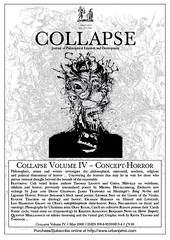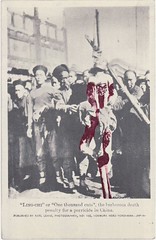
Collapse IV (2008)
Order it here.
This looks interesting. Nice cover too. A bit arcimboldesque. I wonder who did it. This is the cover of a contemporary philosophy magazine of which this issue is dedicated to the theory of horror. Any philosophy of horror and the representation thereof (which is also the theory of the aestheticization of violence) needs to start with Aristotle, as I’ve stated before. Aristotle said on the subject:
“Objects which in themselves we view with pain, we delight to contemplate when reproduced with minute fidelity: such as the forms of the most ignoble animals and of dead bodies.” —Aristotle from the Poetics.
As you may have guessed by now, I have limited first-hand knowledge on some subjects; I do not have the patience to read Aristotle. Nevertheless, in my infinite ignorance, I dare to state that I like Aristotle and dislike Plato. Plato strikes me as a bore (much like Kant does), Aristotle was a sensationalist like myself. From “my” page on aestheticization of violence, Plato comes across as the sort of moral crusader I’ve never felt any sympathy for (except that they have sometimes pointed me in the direction of worthwhile art, see the censor/censored dilemma):
Plato proposed to ban poets from his ideal republic because he feared that their aesthetic ability to construct attractive narratives about immoral behavior would corrupt young minds. Plato’s writings refer to poetry as a kind of rhetoric, whose “…influence is pervasive and often harmful.” Plato believed that poetry that was “unregulated by philosophy is a danger to soul and community.” He warned that tragic poetry can produce “a disordered psychic regime or constitution” by inducing “a dream-like, uncritical state in which we lose ourselves in …sorrow, grief, anger, [and] resentment.
Back to contemporary philosophy. From Wikpedia:
“Philosophy has re-entered popular culture through the work of authors such as Alain de Botton. This trend is reinforced by the recent increase in films with philosophical content. Some films, such as Fight Club, eXistenZ, The Matrix trilogy, Little Miss Sunshine, and Waking Life have philosophical themes underpinning their overarching plots. Other films attempt to be overtly philosophical, such as I ♥ Huckabees.”
I’ve done Fight Club, eXistenZ, The Matrix and Little Miss Sunshine and of those three I like eXistenZ best. I will want to see Waking Life and I ♥ Huckabees. Where do I start. Huckabees? It stars Huppert. And from what I’ve Youtubed of Waking, it reminded me of Scanner Darkly, with which I was not too impressed (but has lingered on afterwards). Any thoughts, dear readers?
Update 17/4: More on Collapse. Collapse has links with New Weird and Speculative realism. The cover is probably by the Chapmans (“new etchings from Jake Chapman“). Of all its contributions I am most curious about Graham Harman on the unnatural bond between Husserl and Lovecraft and Iain Hamilton Grant on Lorenz Oken‘s naturphilosophische slime-horror.



